RAPA NUI
The tremendous, pure heads,
long in the neck and lugubrious,
with jawbones of giants, erect
in the pride of their solitude -
those presences,
preoccupied,
arrogant presences.
long in the neck and lugubrious,
with jawbones of giants, erect
in the pride of their solitude -
those presences,
preoccupied,
arrogant presences.
Pablo Neruda from "The Separate Rose"
A TRADITIONAL POLYNESIAN WELCOME
TURTLE IN THE HARBOUR AT HANGA ROA
I have wanted to visit Rapa Nui ever since encountering the thrilling adventures of Thor Heyerdahl and his crew on Kon Tiki who attempted to prove his theory that the island was populated from South America by sailing a blasa wood raft from Peru and then coming across the classic Easter Island by Alfred Metraux, still one of the best regarded texts on this fascinating culture.A TRADITIONAL POLYNESIAN WELCOME
TURTLE IN THE HARBOUR AT HANGA ROA
FEMALE MOAI FOUND BY THE HEYERDAHL TEAM
A five hour flight from Santiago, this tiny speck in the South Pacific is one of the most isolated places on earth. It was "discovered by the Dutch sailor Jacob Roggeveen on Easter Sunday 1722 and his log constutes the earliest written account of the island.The eerie landscape is scattered with an extraordinary collection of historic sites including the iconic moai (statues) in various stages of completion, erection and demolition. There are 400 finished statues scattered around the island and as almost as many in the statue quarry. Archaologists suggest that the earliest moai were carved around 1000AD and that production reached its peak in the 1500's.
The small town of Hanga Roa is the capital of the island and along the shore stands an ahu which formed part of an important ceremonial centre for the settlement. In the past a significant moai stood here but it was removed and now stands in a Belgian museum.
THE ISLAND CEMETERY
The islands of Polynesia are scattered over the Pacific in a rough triangular shape with Hawa'ii to the north, Aotearoa (NZ) to the east and Rapa Nui to the west, these three the most recently colonized. According to tradition, Hotu Matu'a arrived in Rapa Nui from the Marquesas in two double canoes around 400AD navigating by the stars and such signals as the flying routes of birds, clouds and colour of the sky and water changes. The English sailor William Dampier remarked "they navigate the best boats in the world"
The carvings were done with stone tools and the small museum held an excellent display of artifacts and photographs
MOAI ARINGA ERUA
As in the rest of Polynesia wooden figures, which for their owners were once sacred, became goods for exchange with visitors
HEAD OF A MOAI
This head has cavities for the eyes, which demonstrates that the moai of which it was part was installed at one time on an ahu (platform)
PREPARING A CURANTO
Food was cooked on hot stones beneath a covering of earth in much the same way as a Maori hangi today
Of all the clothes worn by the islanders, topknots were the most valued and were made in different materials and forms. In ancient times, men used mainly feathers and women wove totara reeds for their topknots.
Alfred Metraux
Tattoo art was a slow process which began during infancy and developed through different stages of life accordingto the experience and social position of the person.
A boy adorned for the initiation ceremony of Poku Manu (birdboy)
Perforation and elongation of the ear lobes is the most well known decorationn technique of Rapa Nui culture due to the legend of
long-eared and short-eared people
THE HIGH LAVA CLIFFS
The triangular shape of Rapa Nui is the result of the eruption of the three main volcanoes and about 70 secondary volcanic cones which formed an island of 173 square km in area with a rocky and irregular coast. There was extensive vegetation including palm trees and the toromiro which is now extinct.
PUMPKINS USED AS WATER CONTAINERS
Intensively cultivated gardens yielded a surplus which supported an increased population including a priestly caste, artisans and laborers who produced the moai and ahu and a warrior caste. Sheer numbers eventually threatened the available resources and this resulted in warfare by the late 17th century shortly before the European arrival and numbers began to decline.
Although the giant moai (statues) are the most pervasive image of Rapa Nui, several other types of stone work were created most notably the ahu (ceremonial platforms) on which the moai were erected, burial cairns and the foundations of hare paenga boat shaped houses which were thatched.
The density of ruins is remarkable but many were dismantled and the materials reused for construction. In recent years, a remarkable job has been done in restoring monuments.
AHU
PUKAO (TOPKNOTS)
MOAI WITH TOPKNOT AND EYES
Made from red volcanic scoria, it is believed that the cylindrical topknots on many moai reflect a male hairstyle once common on Rapa Nui
Although most moai may look similar, they are all different and it is thought that the chiefs and powerful members of each clan may have commissioned them as a memorial.
It is considered that the tradition of hewing and erecting the moai was part of a cult of worship of the ancestors. Once the statue was erected on the ahu it possessed mana, the supernatural force that animated the function of important daily activities.
Dissension between the clans led to the toppling of many moai from their ahu and natural disasters such as earthquakes and tsunamis also contributed to the destruction.
The discovery of the islands by the outside world almost resulted in the annihilation of the Rapa Nui and a sad history of exploitation followed. First came the whalers and then planters trying to satisfy the demand for tropical commodities such as rubber and sugar. In 1862, slavers kidnapped a thousand islanders, including the king to work on Peru's Chincha Islands mining guano. When protests resulted in the return of this group, 90% had already been killed by disease and those who didn't die on theship brought back an epidemic of smallpox. Further disaster came in the form of Catholic missionaries who converted the remaining islanders suppressing and degrading local customs and practices. In 1870 the island became a sheep ranch first under the French and then the British and this continued until the mid 20th century when the Chilean government took charge of the island and Rapa Nui remained under military rule for many years. It was not until 1964 that the islanders were allowed outside Hanga Roa (let alone off the island) and granted full citizenship and the right to vote
CRUISE SHIP VISITING THE ISLAND
Today, despite being 3700km from the mainland, Rapa Nui is considered part of the region of Valparaiso but increasing tourism has brought prosperity to the islanders. The land is badly degraded since the destruction of the vegetation was followed by sheep farming and then introduced horses who now number 7000 and run wild outnumbering the human population of 5000
A tour along the south coast with Claudia, a Rapa Nui woman with a wide knowledge of the history and culture of her people proved an excellent introduction to the island. Among the sites we visited was the extinct volcano Rano Raraku, known as "the nursery".
This is the quarry for the hard tufa from which the moai were cut and they can be seen in all stages of production. Most of the moai on the south slope are buried up to their necks in earth and others are still attached to the rock including a 21m giant moai, the largest ever carved
Climbing to the rim of the crater a further 20 standing moai come into view plus a number of fallen ones and others partly finished. Excavation work is revealing the full size of some of these statues
AHU TONGARIKI
At this site, the largest ever built, 15 moai were re-erected by the Japanese company Tadano. The 1960 tsunami had flattened the statues and scattered the topknots far inland. Only one topknot has been replaced on top of a moai
RANO KAU
The crater lake of the extinct volcano Rano Kau is almost covered in a bog of floating totara reeds. Perched 400m above on the edge of the crater wall and abutting a vertical drop into the ocean stand the Orongo ceremonial village.
The ritual of the birdman took place here each year at the September equinox when the various clans gathered to take part in a ritual competion. The object of this was to find the first egg laid by the sooty tern, a migratory bird on Motu Nui, the largest of three islets off the coast.
Each chief would choose a representitive or hopu who would scale the sheer cliff and swim out to the island. It could take several weeks for the egg to be found and during this time the chiefs would remain in the village participating in ritual songs, dances and prayers
Once the egg was found, the victorious chief became the new tangata manu or birdman.
A number of basalt outcrops on the rim feature beautifully carved petroglyphs depicting curled up human figures with bird's heads and long curved beaks. These images honour an important annual ceremony dedicated to the cult of the birdman
Many moai were stolen from the island and the photographs shows American sailors removing a fine example. Twenty nine rongo rongo tablets inscribed in a script which has never been deciphered have also been spirited off to overseas museums in Santiago, London, Rome and Washington DC
Some of the bodies will never assume their full stature,
their arms shapelessly locked
into craters, asleep:
bedded down in calcareous rose,
never lifting their eyes to the sea,
sleeping the leviathan’s horizontal sleep,
stone larvae of mystery,
they lie now, abandoned when the wind fled from the earth
and the procreation of the children of lava ceased.
their arms shapelessly locked
into craters, asleep:
bedded down in calcareous rose,
never lifting their eyes to the sea,
sleeping the leviathan’s horizontal sleep,
stone larvae of mystery,
they lie now, abandoned when the wind fled from the earth
and the procreation of the children of lava ceased.
Pablo Neruda
from "The Seperate Rose"




















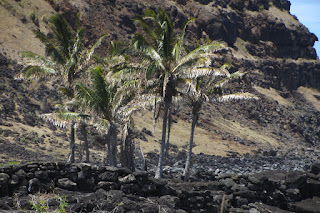


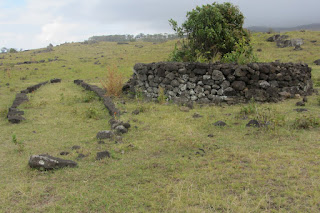





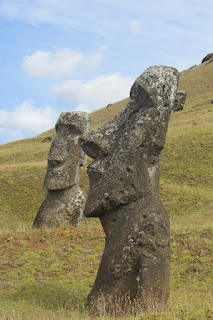






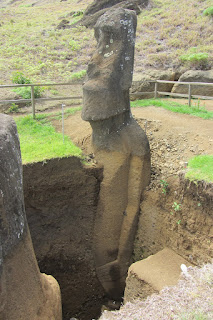






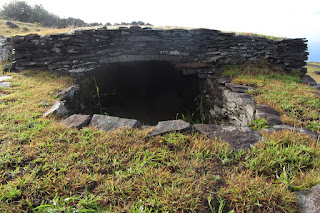











No comments:
Post a Comment